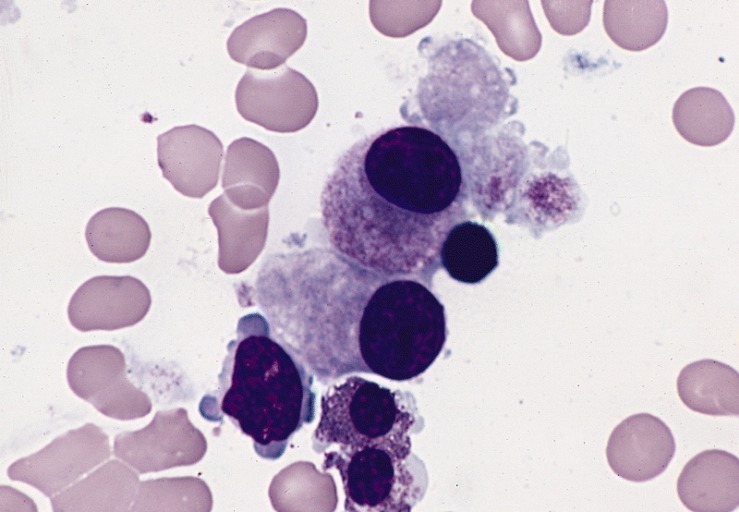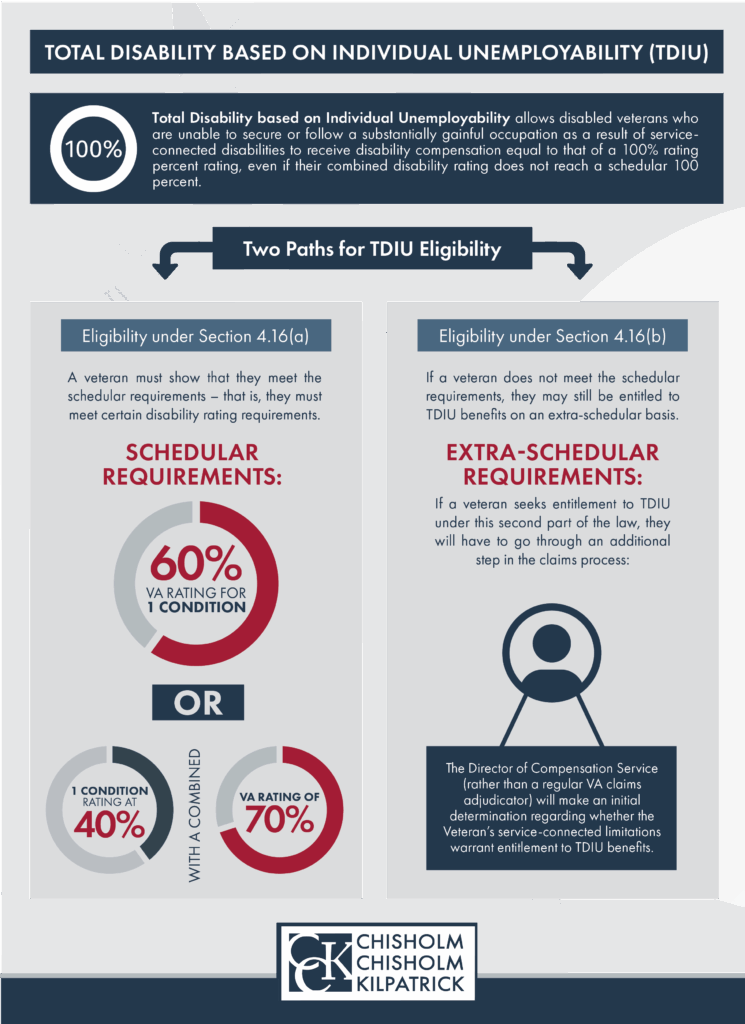VA Disability for Myelodysplastic Syndromes (MDS) from Agent Orange Exposure

CCK Law: Our Vital Role in Veterans Law
Myelodysplastic syndromes (MDS) are a group of serious bone marrow disorders that can impact the production of blood cells in a veteran’s body and even lead to the development of blood cancers like acute myeloid leukemia. Some veterans who were exposed to toxic chemicals like Agent Orange have gone on to develop MDS. If you are a veteran suffering from this condition and believe your MDS and Agent Orange exposure are connected, then you may qualify for monthly compensation from VA.
This article by Chisholm Chisholm & Kilpatrick will guide you through VA’s claims process so you can begin earning the benefits and compensation that you are entitled to.
Key Features:
- Understand what Myelodysplastic Syndromes (MDS) are from VA’s perspective
- Prove that MDS is caused by service, such as Agent Orange exposure
- Learn VA’s disability ratings and compensation rates for MDS
- And more
What Are Myelodysplastic Syndromes (MDS) from VA’s Perspective?
Myelodysplastic syndromes (MDS) are a group of disorders that negatively affect the bone marrow, which is responsible for producing healthy blood cells in the body. When a veteran suffers from MDS, their bone marrow becomes less effective at creating blood cells, leading to malformed blood cells and lower overall cell counts.
Depending on the type of MDS a veteran has and the cells their marrow has trouble producing, they may end up developing anemia (low red blood cell count), leukopenia (low white blood cell count), or thrombocytopenia (low platelet count).
MDS and low blood cell counts can lead to a variety of symptoms, including:
- Weakness or fatigue
- Dizziness
- Shortness of breath
- Inability to fight infections
- Skin discoloration
- Rashes and hives
- Easy bruising
- Excessive bleeding from wounds or nosebleeds
- Blood in urine or stool
Notably, the scientific community generally classifies MDS as either a form of cancer or pre-cancer. One 2022 study shows that, depending on the type of MDS a patient suffers from, they have a 30-55 percent chance of going on to develop acute myeloid leukemia as a result of the disorder.
What Causes Myelodysplastic Syndrome?
While the exact cause of MDS is still unknown, studies indicate that damage to the body’s DNA or to bone marrow cells in particular may play a prominent role in the development of the disorder.
Some factors that could cause this cellular damage or otherwise put veterans at an increased risk of developing MDS include:
- Inheriting a genetic predisposition for the condition
- Suffering from pre-existing bone marrow disorders
- Smoking tobacco
- Undergoing chemotherapy or radiation therapy
- Being exposed to toxic chemicals or pesticides, like in the rubber or agricultural industries
Does VA Accept that Myelodysplastic Syndromes (MDS) Can Be Caused by Agent Orange?
MDS and Agent Orange are often associated with each other due to the toxins within Agent Orange having the potential to cause the cellular damage necessary for a veteran to develop myelodysplastic syndromes or other serious conditions.
During the Vietnam War, many veterans were exposed to Agent Orange, an herbicide that was dispersed over vast swathes of the Vietnamese landscape. Agent Orange was a mixture of herbicides 2,4-D and 2,4,5-T., a potent toxic chemical that persists in the environment, as well as dioxin (TCDD) as a contaminant; these can cause adverse physical effects for those who come in contact with them.
Maura Black, a Partner at CCK Law, describes the health risks involved with exposure to this herbicide: “Agent Orange is by far the most infamous of the [herbicides used during the war]. The bottom line is that it is a dioxin that can be very harmful and cause long-term health effects such as immune system disorders, reproductive disorders, developmental issues, and cancers.”
Watch CCK Law attorneys and advocates discuss “7 Things Every Veteran Should Know About Agent Orange”:

Are Myelodysplastic Syndromes (MDS) a Presumptive Disorder for Agent Orange Exposure?
With the Agent Orange Act of 1991, VA acknowledged a specific list of health conditions as linked to Agent Orange exposure. The Agent Orange Act has expired, and VA now adds conditions under authority from 38 U.S.C. § 1116(b). These are known as presumptive conditions, which means that if a veteran is diagnosed with one of them and can show they were stationed at a time and place where Agent Orange existed, VA will automatically recognize the condition as connected to service.
Unfortunately, however, myelodysplastic syndrome is not included among VA’s presumptive conditions associated with Agent Orange exposure. (MDS may progress to acute myeloid leukemia, which is presumptive under 38 CFR § 3.309(e).)
However, this does not prevent benefits. Jenna Zellmer, another Partner at CCL Law, explains the significance of this:
“One important thing to know is that, even though VA has this list of presumptive conditions, that doesn’t necessarily mean you can’t get service connected for a different condition due to Agent Orange exposure. You just wouldn’t be granted the presumption of nexus, which means you would need to go out and get a VA exam or a doctor’s opinion that relates your current disability to your Agent Orange exposure.”
In other words, veterans seeking disability benefits for MDS linked to Agent Orange must establish a direct or secondary service connection through supporting evidence rather than relying on a presumptive classification.
How Do Veterans Prove Myelodysplastic Syndromes (MDS) Are Caused by Military Service?
When a veteran proves service connection, it means they have provided VA sufficient evidence establishing a medical relationship between their condition and their time in the military. Veterans have a few different pathways available to establish this connection.
Direct Service Connection for MDS Related to Agent Orange Exposure
To prove a direct service connection, veterans must demonstrate that their diagnosed condition was either caused by or aggravated by their service. If they are trying to prove their MDS is a result of Agent Orange exposure, then they would need to provide three key pieces of evidence to VA:
- A confirmed medical diagnosis of MDS,
- Records showing they served in a time and location where exposure to Agent Orange was possible, and
- A medical nexus—a healthcare provider’s professional opinion that the veteran’s MDS is “at least as likely as not” related to their encounter with Agent Orange
VA typically relies on expert medical opinions to assess whether a condition is related to a veteran’s service. To make this determination, VA frequently schedules a Compensation and Pension (C&P) exam, which plays a key role in evaluating the connection between the condition and the veteran’s time in uniform.
Secondary Service Connection for MDS Related to Agent Orange Exposure
A secondary service connection refers to a health condition that arises because of another condition the VA has already deemed service connected.
Put simply, veterans may qualify for secondary service connection if they can show that their MDS developed as a result of a separate, already service-connected condition. For instance:
- Say a veteran served on a base in Vietnam where they suffered exposure to Agent Orange. The damage Agent Orange caused to their body eventually led the veteran to develop prostate cancer. Since prostate cancer is on the list of conditions presumed to be linked to Agent Orange, VA automatically recognizes the veteran’s cancer as service connected, and grants them a disability rating and monthly compensation.
- The veteran undergoes chemotherapy and radiation therapy to treat their prostate cancer. However, over the course of their treatment, these therapies actually damage the veteran’s bone marrow cells and DNA, and years later, the veteran is diagnosed with MDS as a result.
- In these circumstances, since the veteran’s MDS developed as a result of treatment for their already service-connected prostate cancer, the veteran would be able to file a disability claim for MDS as secondary to their cancer and could potentially earn additional benefits if their claim is successful.
Watch CCK Law attorneys and advocates discuss secondary conditions caused by Agent Orange exposure:

What Evidence Does VA Look for in MDS Claims Related to Agent Orange Exposure?
When trying to prove service connection between MDS and Agent Orange exposure, the quality and relevance of the evidence submitted can significantly impact the outcome of the claim. Veterans can strengthen their case by including several key forms of documentation:
- Service Records – These documents can help establish a connection between the veteran’s toxic exposure and their current symptoms. Examples include medical evaluations conducted during service, personnel files, discharge documents, and other relevant military records.
- Medical Documentation – Providing thorough medical records is critical for verifying both the MDS diagnosis and any ongoing treatment. These records may come from VA facilities, private physicians, or written statements from healthcare professionals familiar with the veteran’s condition.
Additionally, personal accounts from individuals who know the veteran—such as family members, close friends, or fellow service members—can shed light on how MDS affects daily living. While these lay statements do not carry the same weight as official records, they can still add valuable perspective for VA during the review process.
What to Expect at a Compensation & Pension (C&P) Exam for MDS
A Compensation and Pension (C&P) exam is a medical evaluation conducted by either a VA healthcare provider or an approved VA contractor. This exam is an essential part of VA’s decision-making process, helping determine whether a veteran’s condition is connected to their military service. It also provides critical information VA uses to assign a disability rating after service connection has been confirmed.
Though C&P exams for MDS will likely vary depending on symptom severity and the professional conducting the exam, veterans should generally prepare for the following:
- A physical exam where the VA provider checks for skin discoloration, assesses the veteran’s level of pain or fatigue, and examines their body for evidence of other MDS symptoms.
- A questionnaire portion where the examiner asks how the veteran’s symptoms affect their everyday activities and overall well-being. They may also ask about any medical treatments the veteran has undergone for MDS, along with how effective those treatments have been.
- Blood tests like a complete blood count (CBC) or a peripheral blood smear. A CBC checks for low blood cell counts in the body, while the blood smear assesses cell shape and size to determine if there are any malformations.
- A bone marrow aspiration or biopsy. These tests involve the removal of bone marrow samples from the body to check for biological markers of MDS.
Once the VA examiner determines the severity of a veteran’s MDS, the next stage of the process is for VA to assign the veteran a disability rating for their condition.
What Is the VA Rating for MDS?
VA does not have a specific diagnostic code for MDS. MDS is typically rated analogously under DC 7700 (anemia) or DC 7716 (myelofibrosis) of 38 CFR § 4.117 – Ratings of the Hematologic and Lymphatic Systems depending on symptoms. Under these criteria, veterans can receive MDS disability ratings of 30, 60, or 100 percent. The criteria are as follows:
- 100 percent – Requiring peripheral blood or bone marrow stem cell transplant; or requiring chemotherapy
- 60 percent – Requiring 4 or more blood or platelet transfusions per 12-month period; or infections requiring hospitalization 3 or more times per 12-month period
- 30 percent – Requiring at least 1 but no more than 3 blood or platelet transfusions per 12-month period; infections requiring hospitalization at least 1 but no more than 2 times per 12-month period; or requiring biologic therapy on an ongoing basis or erythropoiesis stimulating agent (ESA) for 12 weeks or less per 12-month period
Importantly, 100 percent ratings for MDS are typically only applied when the veteran is first admitted to the hospital for their transplant or chemotherapy. Six months after their hospital discharge or completion of their chemotherapy treatment, their rating will be reevaluated by VA.
Additionally, if the veteran’s MDS progresses into acute myeloid leukemia or some other form of leukemia, they will instead be rated under Diagnostic Code 7703.
VA Compensation for MDS
In most cases, a higher VA disability rating for MDS leads to increased monthly compensation from VA. The chart below outlines the payment amounts veterans may be eligible for in 2025 based on their assigned VA rating of 30, 60, or 100 percent.
As of 2025, the VA disability rate benefit amounts are as follows:
- 0 percent disability rating: $0.00 per month
- 10 percent disability rating: $175.51 per month
- 20 percent disability rating: $346.95 per month
- 30 percent disability rating: $537.42 per month
- 40 percent disability rating: $774.16 per month
- 50 percent disability rating: $1,102.04 per month
- 60 percent disability rating: $1,395.93 per month
- 70 percent disability rating: $1,759.19 per month
- 80 percent disability rating: $2,044.89 per month
- 90 percent disability rating: $2,297.96 per month
- 100 percent disability rating: $3,831.30 per month
Veterans may also qualify for additional compensation if they have eligible dependents, which can further increase their monthly benefit. Check out the following article to learn more about dependent benefits: “VA Benefits for Dependents of Disabled Veterans”.
Special Monthly Compensation (SMC) for MDS
Special Monthly Compensation (SMC) is an added benefit VA provides to assist veterans facing serious disabilities or complex medical conditions. These alternative payment rates are designed to help cover expenses and needs that standard VA disability compensation might not fully meet.
In some cases, MDS can result in lasting health complications or lead to serious conditions like cancer. When MDS is especially severe—or when it combines with other service-connected issues to create a more significant overall impact—VA may grant additional compensation through SMC.
Watch CCK Law attorneys and advocates discuss the Pact Act:

Can I Get Total Disability for MDS?
Yes. Ratings related to MDS can be as high as 100 percent.
Even veterans who do not have a 100 percent schedular rating for MDS may be able to receive full disability compensation. Total Disability based on Individual Unemployability (TDIU) is available to veterans whose service-connected conditions prevent them from obtaining or maintaining substantially gainful employment. Through TDIU, veterans may receive compensation at the 100 percent rate, regardless of whether their combined rating actually totals 100 percent.
There are two primary paths to TDIU eligibility:
- Schedular TDIU – Veterans may qualify if they meet one of the following rating criteria:
- A single service-connected condition rated at least 60 percent, or
- A combined disability rating of 70 percent or more, with at least one individual condition rated 40 percent or higher.
- Extraschedular TDIU – Veterans who do not meet the above thresholds can still be considered under this alternative. In these cases, VA’s Director of Compensation Services reviews the claim to determine whether the veteran’s service-connected impairments prevent gainful employment, even if the rating percentages fall short.
Because TDIU claims can be complex and often require detailed medical and vocational evidence, it is a good idea to seek help from a VA-accredited representative—like a certified claims agent or an experienced attorney. If you would like support, consider contacting CCK Law for a free case evaluation.

Want to Appeal a VA Decision Related to MDS? Contact CCK Law
Filing an appeal for an MDS and Agent Orange VA claim can be discouraging, particularly if VA outright denied your initial claim.
The good news is that working with a VA-accredited attorney can help simplify the appeals process and improve your chances of reversing VA’s decision so you can earn the compensation you deserve. CCK Law’s extensive experience—tens of thousands of cases—means that we have seen what evidence is most effective and gets correct results quickly.
Call CCK Law today at (800) 544-9144 or contact us online to tell us about your case.
About the Author
Share this Post
